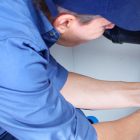Washing Machine Filter maintenance is often overlooked, but it’s essential for keeping your washing machine in top shape. Over time, dirt, lint, and debris can build up, causing your washing machine to work less efficiently. Cleaning the filter not only ensures the machine functions properly, but it also extends its lifespan, reduces the risk of damage, and can save you on repair costs. In this guide, we’ll take you through the entire process to help you keep your machine running smoothly.
Contents
Why It’s Important to Clean Your Washing Machine Filter
Most people don’t realize that a Washing Machine Filter is like the heart of your washing machine. It traps all kinds of debris—lint, loose threads, hair, and even small objects that may fall out of your pockets. If left unchecked, these particles can clog the filter, making your machine work harder, which can lead to energy inefficiency and, eventually, a breakdown.
1. Enhanced Washing Performance
A clean Washing Machine Filter allows water to flow freely through the system. When the filter gets clogged, it restricts water circulation, which makes the machine struggle to properly rinse and clean your clothes. You may notice that your clothes don’t smell as fresh or that detergent residue is left on them after a wash. Keeping your filter clean will ensure the machine works as it should, leaving your laundry clean and fresh.
2. Extending the Machine’s Lifespan
Overworking a machine with a blocked filter can put a lot of stress on its components. If the filter is dirty, the washing machine has to push harder to pump water, which wears down the motor and other parts faster than normal. By regularly cleaning the Washing Machine Filter, you’re essentially taking good care of your appliance, helping it last longer, and avoiding costly repairs or replacements.
3. Preventing Bad Odors and Mold Growth
A clogged filter can cause water to sit stagnant inside the machine, leading to the growth of mold and bacteria. This can make your washing machine smell bad and leave a musty odor on your clothes. Cleaning your Washing Machine Filter helps eliminate these odors and keeps your laundry smelling fresh every time.
Now that you understand why it’s so important to clean your filter, let’s dive into the step-by-step process.
How to Locate the Washing Machine Filter
Before you can clean the Washing Machine Filter, you need to know where to find it. The filter’s location depends on the type and model of the washing machine you have. Generally, the filter is located either at the front or rear of the machine.
1. Front-Loading Washing Machines
For most front-loading machines, the Washing Machine Filter is typically located at the bottom front of the appliance. You’ll often find it behind a small access panel that’s easy to open.
- Look near the base of the machine and spot the panel.
- Use a flathead screwdriver or your hands to open the access door.
- The filter will usually be visible, but if you can’t spot it immediately, check the user manual or look for online resources for your specific model.
2. Top-Loading Washing Machines
Top-loading washing machines usually have a Washing Machine Filter located inside the agitator or near the drain pump. You might need to remove the agitator to access the filter, depending on the model.
- Lift the lid of your top-loading washer.
- Check inside the agitator (the central post in the drum) or around the edges of the drum for a filter.
- If you don’t see it, the filter could be located at the back, near the water pump.
If you’re still unsure of your machine’s Washing Machine Filter location, consult the manufacturer’s manual for specific guidance. Now that you’ve located the filter, it’s time to clean it.
Step-by-Step Guide to Clean a Washing Machine Filter
Cleaning your Washing Machine Filter doesn’t require special tools or a lot of time, but it’s essential to do it regularly. Follow these steps to ensure a thorough cleaning:
1. Turn Off and Unplug the Washing Machine
Before you start, always ensure your washing machine is turned off and unplugged. This is a crucial safety step to avoid any electrical shocks. If your machine is connected to the water supply, it’s also a good idea to turn off the water valves.
2. Prepare the Area
Once you’ve located the Washing Machine Filter, prepare the area by placing towels or a shallow tray underneath the filter. When you open the filter compartment, water trapped inside the machine may spill out. The towels will help absorb the water and prevent a mess.
3. Remove the Filter
Carefully unscrew or pull out the Washing Machine Filter, depending on the type of machine you have. Some filters are simply pulled out, while others might need a twist to unlock. Be gentle, as forcing it could damage the filter or the machine.
4. Clean the Filter
Now comes the fun part—cleaning the filter! Here’s how:
- Rinse the Washing Machine Filter under running water. You can use an old toothbrush or a soft cloth to scrub off any lint, dirt, and debris stuck in the mesh.
- If the filter is clogged with grime, soak it in a bowl of hot, soapy water for 10-15 minutes. This will loosen any stubborn dirt, making it easier to clean.
- Check the filter housing in the machine for any debris. Wipe it clean with a damp cloth before reinserting the filter.
5. Replace the Filter
Once the Washing Machine Filter is thoroughly cleaned, it’s time to place it back into its housing. Secure the filter in place, making sure it’s properly seated, and close the access panel.
6. Run a Test Cycle
After replacing the filter, run a short wash cycle (without clothes) to ensure everything is functioning smoothly. This will also flush out any remaining debris and confirm that the Washing Machine Filter is properly installed.
How Often Should You Clean the Washing Machine Filter?
The frequency of cleaning your Washing Machine Filter depends on how often you use the machine and the type of fabrics you wash. If you have pets or frequently wash items that shed lint, you may need to clean the filter more often. As a general rule:
- Light use: Clean the filter every 3-4 months.
- Moderate use: Clean the filter every 2-3 months.
- Heavy use: Clean the filter monthly.
It’s always a good idea to check the filter regularly, especially if you notice any issues with your machine, like slow drainage, longer wash times, or clothes not coming out as clean as they should.
Signs That Your Washing Machine Filter Needs Cleaning
Not sure if your Washing Machine Filter is due for a cleaning? Here are some signs that it’s time to give it some attention:
1. Clothes Coming Out Dirty
If your clothes are coming out of the wash with residue or dirt still on them, it’s likely because the Washing Machine Filter is clogged. This prevents proper water flow, resulting in less effective cleaning.
2. Longer Wash Cycles
A clogged filter can make your washing machine take longer to complete a cycle. If you’ve noticed that your machine is running longer than usual, it’s time to check the filter.
3. Strange Noises
Hearing unusual noises during a wash cycle? A clogged Washing Machine Filter can cause the motor to strain and make odd sounds as it works harder to pump water through a blocked system.
4. Water Drainage Issues
Slow or incomplete water drainage is another common sign that the filter is clogged. Water may pool at the bottom of the drum or take a long time to drain after a wash.
5. Bad Odors
A foul smell from your washing machine is often caused by a dirty Washing Machine Filter. The buildup of mold, lint, and debris in the filter can create a breeding ground for bacteria, leading to unpleasant odors.
Conclusion
Cleaning your Washing Machine Filter is a simple task that can make a world of difference in how your washing machine performs. Regular maintenance ensures your machine stays efficient, extends its life, and keeps your clothes looking and smelling fresh. By following this guide, you can easily maintain your machine and avoid costly repairs down the line.
For any issues or questions, don’t hesitate to reach out to us at 0508700774. We’re here to help!



